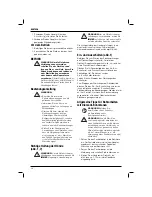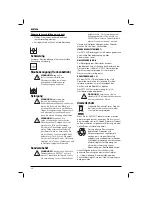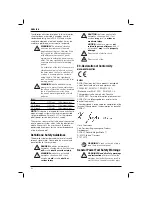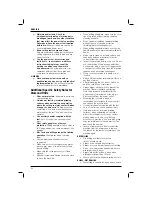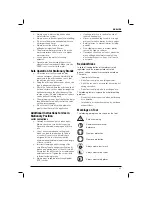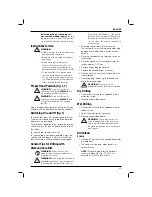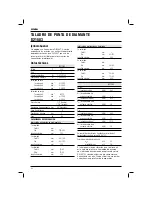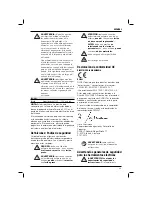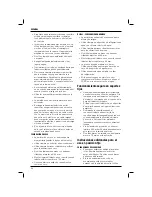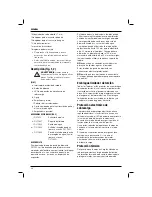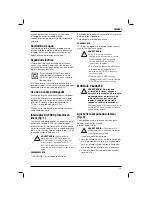
ENGLISH
34
e)
Maintain power tools. Check for
misalignment or binding of moving parts,
breakage of parts and any other condition
that may affect the power tool’s operation.
If damaged, have the power tool repaired
before use.
Many accidents are caused by
poorly maintained power tools.
f)
Keep cutting tools sharp and clean.
Properly maintained cutting tools with sharp
cutting edges are less likely to bind and are
easier to control.
g)
Use the power tool, accessories and
tool bits etc., in accordance with these
instructions taking into account the
working conditions and the work to
be performed.
Use of the power tool for
operations different from those intended
could result in a hazardous situation.
5) SERVICE
a)
Have your power tool serviced by a
qualified repair person using only identical
replacement parts.
This will ensure that the
safety of the power tool is maintained.
Additional Specifi c Safety Rules for
Diamond Drills
•
Wear ear protectors.
Exposure to noise can
cause hearing loss.
•
Hold power tools by insulated gripping
surfaces when performing an operation
where the cutting tool may contact hidden
wiring or its own cord.
Cutting accessory
contacting a “live” wire may make exposed
metal parts of the tool “live” and shock the
operator.
•
Use auxiliary handles supplied with the
tool.
Loss of control can cause personal
injury.
•
Wear safety goggles or other eye
protection.
Drilling operations cause chips to
fly. Flying particles can cause permanent eye
damage.
•
Bits, tools and drilling area get hot during
operation.
Wear gloves when touching
them.
•
Use the diamond drill under constant
supervision.
•
Make sure not to cut through electric mains,
gas or water pipes. Use detection systems
prior to drilling.
•
Make sure the cutting accessory is fitted
properly.
•
Check all screws and tighten securely before
you use the machine.
•
When drilling downward, make sure the core
can drop safely without injuring someone
standing beneath.
•
Do not perform overhead (upward) drilling
without the use of suitable protection
shielding (water collecting device).
•
When drilling handheld, always use the side
handle and hold the machine firmly with both
hands.
•
Make sure to stand on a stable surface and
keep body balance at all times for better
control of reaction torque.
•
Inspect the machine before every use. Do not
use the machine if there are any defectives
on the mains plug, power cord, trigger switch
or any part of the housing. Have the machine
repaired by an authorized repair agent.
•
Do not use the machine in a damp or wet
location.
•
Switch off the machine immediately if there is
any leak of water.
•
After interrupting the cut, do not switch on
until the core bit can rotate freely.
•
Always trigger off the switch to prevent the
machine from accidentally self starting.
Note this procedure especially after the
power supply is interrupted or the plug is
disconnected from the power outlet.
•
Mounting the tool onto a stand is
recommended to increase the user comfort
and reduce the risk of injuries.
•
Use auxilary handles supplied with the tool.
•
Loss of control can cause personal injury.
•
Hold power tool by insulated gripping
surfaces, when performing an operation
where the cutting accessory may contact
hidden wiring or its own cord. Cutting
accessory contacting a "live" wire may make
exposed metal parts of the power tool "live"
and shock the operator.
•
In case of jammed core bit disconnect the
machine from the power supply, remove
the reason for the jam before turning on the
machine again.
DRY DRILLING
•
Dry drilling is suitable for masonry
(bricks, breeze blocks).
•
Always use a suitable dust extractor.
•
Always use core bits designed for dry drilling.
•
Do not use the machine handheld with core
bits larger than 100 mm.
•
Always mount the drill on a stand when
drilling holes larger than 100 mm.
•
Wear a dust mask when performing dry cuts.
D21583 - WET DRILLING
•
Wet drilling is suitable for stone and concrete.







